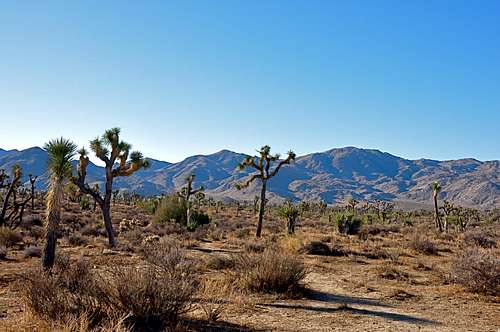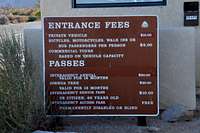-
 4845 Hits
4845 Hits
-
 89.77% Score
89.77% Score
-
 30 Votes
30 Votes
|
|
Mountain/Rock |
|---|---|
|
|
34.01461°N / 116.16858°W |
|
|
Riverside |
|
|
Trad Climbing |
|
|
Spring, Summer, Fall, Winter |
|
|
4000 ft / 1219 m |
|
|
Overview
Elephant Dome and Snake Dome are the names of two rock formations in the Real Hidden Valley area of Joshua Tree National Park, California.
Elephant Dome and Snake Dome are actually two neighboring formations separated by a low point on a shoulder connecting them together. Hence, I have decided to include them in the same page. Unlike the all-time-favorite Hidden Tower, or the very well hidden The Wailing Wall, these two domes are sitting right next to the Nature Loop Trail. During the early days of route development in Joshua Tree these two domes escaped complete attention. In the latter part of the 1970s, however, one route was established on Elephant Dome. Snake Dome, on the other hand, escaped the attention of climbers until the latter part of the 1980s and into 1990s when a number of routes were put up by the likes of Allan Bartlett. Considering the quality and quantity of more impressive rock formations such as Sport Challenge Rock and The Sentinel in close proximity of this area, it should come as no surprise that you would not see a single person climbing on these two domes, even to this day.
Although Elephant Dome is the larger of the two domes, it offers only one moderate route up the middle of its west face. This route is Pachyderm To Paradise, rated 5.9, and it's the original route established in the 1970s. During the mid 1990s a much more difficult route was established on the smooth southwest face to the right of the original route. This route, not shown in the diagram, is rated 11b and protected by several bolts and joins the original route near the top. Snake Dome that was overlooked for many years offered a variety of cracks up the middle of the vertical southwest face. Some of these cracks, such as the one on the far left, not shown in the diagram, and not protectable, became a top rope problem. The cracks on the southwest face, however, showed a greater potential for leading. These two routes are Handlin Snakeskin, rated 10c, and Black Todd, rated 10b. The thin cracks in between these two routes are difficult to protect and are best to be top roped.
List of Select Routes
| select routes of Elephant Dome and Snake Dome | |
| A | Pachyderm To Paradise, 5.9, standard Rack |
| B | Handlin' Snakeskin, 10c, standard Rack |
| C | Black Todd, 10b, Standard Rack |
Geting there
From the western entrance to Joshua Tree National Park drive on Park Boulevard for about nine miles to a major rock formation called “Intersection Rock.” Intersection Rock is a major landmark on the north side of Park Boulevard with ample parking for visitors and climbers alike. This rock, true to its name, sit at the cross roads to Hidden Valley Campground, Barker Dam Road and the road to Day use and picnic area.
Turn right onto the road leading to day use area with a large parking lot and bathrooms. The Trail to “Real Hidden Valley” is obvious and starts here. This trail leads to “Nature Loop Trail” and “Real Hidden Valley.”
Follow the trail through rocky sections and steps to where the trail forks. Take the right fork. After a few minutes you will see a large and steep blocky rock formation to your left. That’s Sport Challenge Rock. Stay on the trail and walk behind Sport Challenge Rock. Elephant Dome and Snake Dome are some 200 yards to the north of Sport Challenge Rock to your right.
Camping, Environmental concerns, noise considerations,
Please tread lightly. The Access Fund has gone to great lengths posting trail marker for approaches to many of the more popular crags. Do your best to stay on these trails, and where you are forced to use a different path, choose the ones that rain can mend in time. Drainages make for good trails where there are no established trails.
Avoid stepping on native and fragile plants, and do not feed the coyotes. Coyotes are very much used to people and often hang around picnic areas and camp grounds in hopes of getting a hand out. It’s better to let them live their natural life.
Camping
There are nine campgrounds in Joshua Tree National Park. At the entrance to the park you are always asked if you would care to have a map and a brochure. The brochure will have plenty of information on the campgrounds and the map will guide you to many of the pleasant hikes throughout the park. You may even get the latest information as to availability of campsites. During the peak season (mid winter through spring) finding a campsite may become a major task. It is highly recommended to use the following link to get more information in advance.
Joshua Tree Camping
Noise considerations
When you are camping with friends and sitting around the fire, it is easy to forget that there are other people trying to sleep in the nearby campsites. It is important to put yourself in their shoes. Keep the noise and music to a minimum and certainly not too much past 10 p.m. Your neighbors will smile at you in the morning instead of giving you dirty looks.









